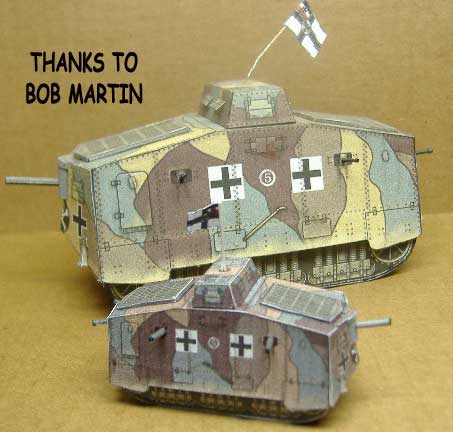
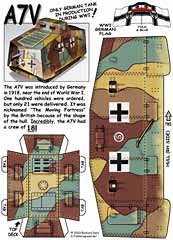
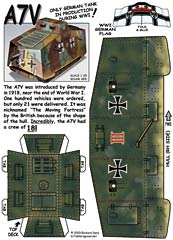
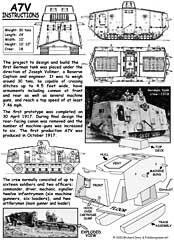
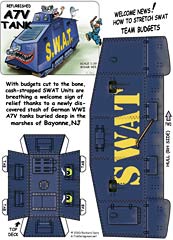
A7V German WWI Tank
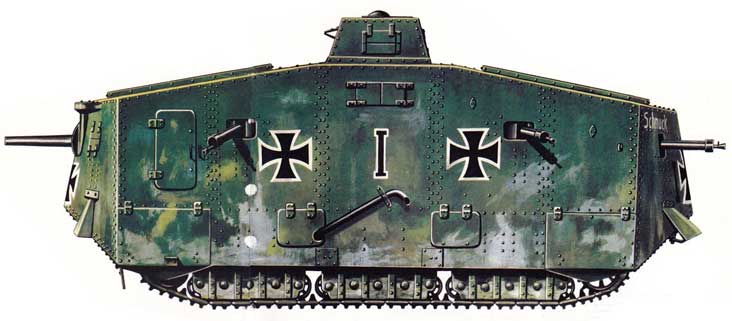 The A7V, the first WWI German tank, took the field in 1918. Tank met tank for the first time at Villers-Bretonneux on April 24, 1918, and too late the Germans realized that the best way to fight a tank is with another tank,, a principle still valid today. |
On 24 April 1918 when three A7Vs (including chassis number 561, known as "Nixe") taking part in an attack with infantry incidentally met three All 18 available A7Vs had been put into action that day with limited results; two toppled over into holes, some encountered engine or armament troubles. After a counterattack, three ended up in Allied hands. One was unusable and scrapped, one used for shell testing by the French, and the third taken by the Australians
It is true that the tank was not "exploited" to the full in World War I despite Colonel Swinton and other early tank corps officers, who from the start had wanted them to be deployed in massed formation. But whatever may have been the shortcomings on the part of the Allies, the tank owed much of its remarkable success to its underestimation by the Germans. The German General Staff did however, but allow the development of anti-tank weapons. 1919 plans for tank construction drawn up by the belligerent powers: The only project to be produced and fielded was the A7V, although only fifteen A7Vs were built. The majority of the roughly hundred or so tanks fielded by Germany were captured British and French vehicles. A7Vs were captured by the Allies, but they were not used, and most ended up being scrapped. |
What people are Saying: Please tell Richard that these tanks he has been designing are fantastic. Just beautiful work. I haven't had the chance to build any yet but I am really impressed with the job he is doing. Dan RM ( Delta 7 Studios) 1/11 I logged in today to find the A7V, much to my delight. I am really excited about the WW1 tank line, They are excellent models. I bought a year of magic keys, and will add three more years later in 2011. it is the least i can do with the therapeutic value of your models: They are helping me keep my sanity as I deal with the sudden onset of almost completely losing my hearing. I am getting two hearing aids next month, so hopefully things will work out. I hope things go well with your projects for Veterans and childrens' hospitals. May they get the joy from your efforts that I have. Your friend, Steve P 1/11 I started building the larger format, and yes it is easier, but for me part of the charm of this tank is its small size. I hope you will include the smaller version as well. Putting this two-man light tank next to the other monster tanks like the mark IV or German A7V and comparing the size can be a good way to see the variations in tank design during WWI. I've also looked around at what some of the other modelers have displayed on your web site. I've seen some very impressive work. The JU 87 Stuka for instance has me drooling. I think there are modelers who enjoy a good challenge... Meanwhile, moving forward I'll think large. I suppose its easier to shrink things to make a smaller version later... The larger format would probably be better for museum gift shops, as it will be more appealing to less hard core paper modelers... Richard (the designer)
|
||||||
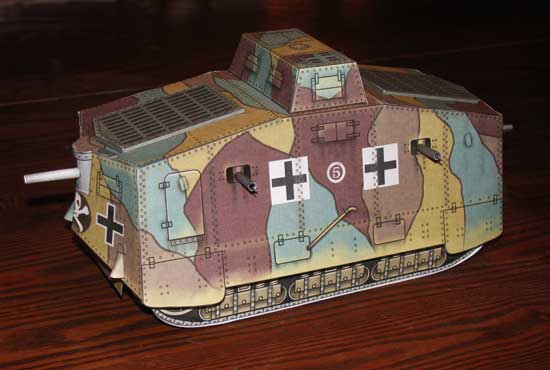 |
Specifications Crew: 18 Weight: 73,700 lbs Length: 26' 3" Width: 10' .5" Height: 10' 10" Range: 25 miles Armor: 0.39 - 1.18" Armament: 57mm, 6 x MG Engines: 2 Daimler 100hp, 4 cylinder engines @100hp ea Speed: 10 mph (with tail wind) Clearance: 5 in |
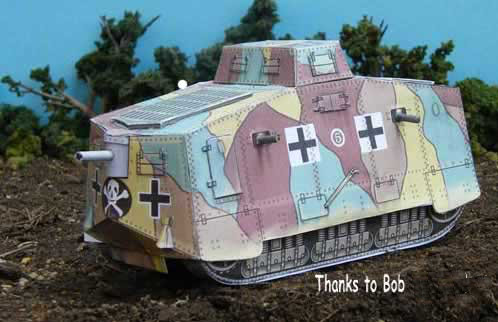 |
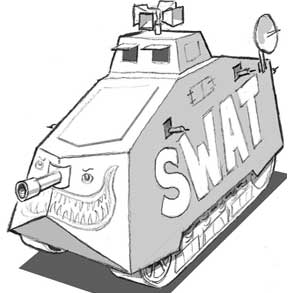 |
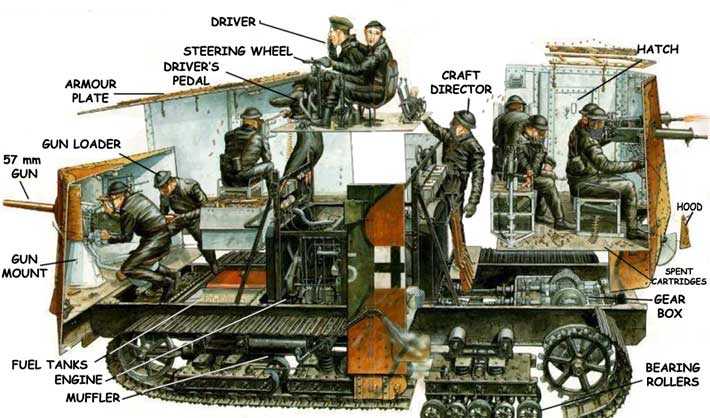 Photos and Australian military history material: Australian War Memorial - Canberra, Australian Capital Territory, Australia |
|
Germany’s Panzerkampfwagen on the Western Front The A7V was a heavy tank designed by the Germans for combat on the Western Front. While design construction and testing began in 1917, combat usage of the A7V did not begin until early 1918. British successes post-Cambrai in regards to armor pushing through German lines led to the development of the German T-Gewehr anti-tank rifle to stop British Whippets (light tanks) from capitalizing on A7V..the Mobile Monster: The A7V itself was a physically tremendous tank which required a minimum of eighteen men to operate the machine and to crew its weapons systems. While the A7V had only 6mm of armor on its roof, the sides and front were well armored. The stern, however, carried 30mm of armor, allowing the tank to push through heavily fortified positions.
Weapons of the A7V: While the A7V Panzerkampfwagen was an impressive machine, Germany had neither the time nor the material to build and perfect enough of them to make a significant contribution to their war effort. The A7V did show, however, that the speed of the British Whippet could be combined with the armor and striking power of the British Mark V heavy tank to provide an awesome weapon. |
 Richard's Beta Build of his A7V large sized WWI tank |
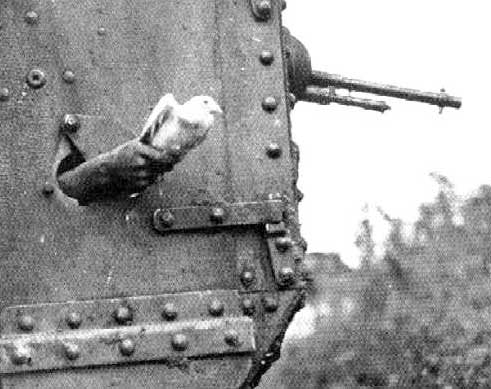 Perhaps this was the very first 'Tweet'. Carrier pigeon was a good way to communicate and the bird was more than happy to get away from the noise and smoke |
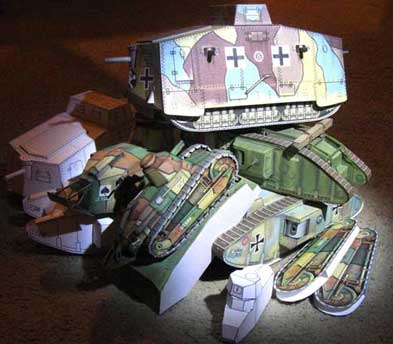 Richard has a great sense of humor as you will see as the Fiddlersgreen tank collection evolves |
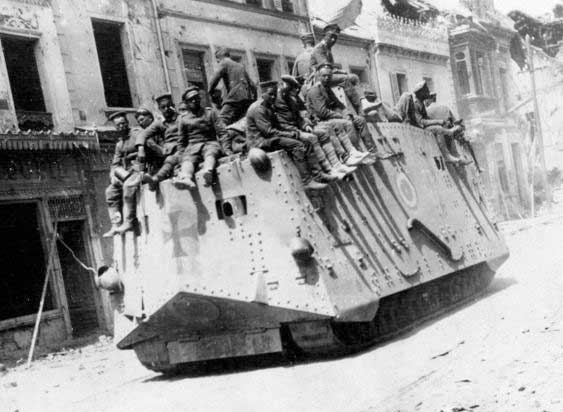 What chance did the Germans have with only fifteen A7Vs and thirty assorted tanks captured from the British? |
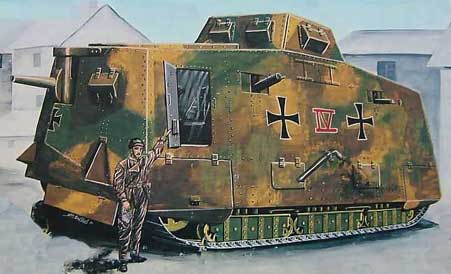 This is an image of a A7V tank kit in plastic. Nice artwork but the hatches seem wrong with the corner effect |
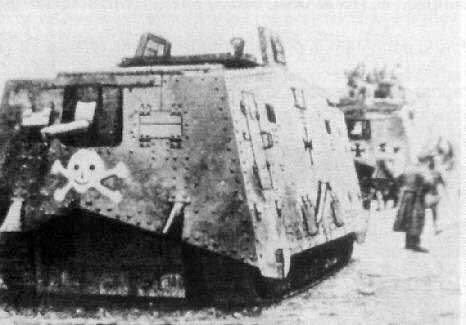 The final use in WWI of A7Vs was in October 1918; a number were scrapped before the war ended in November. |
Pre-production A7V: The project to design and build the first German tank was placed under the direction of Joseph Vollmer, a Reserve Captain and engineer. The new tank was to be a universal chassis which could be used as a base for both a tank and unarmored Oberlandwagen ("Over-land vehicle") cargo carriers. It A wooden mockup of a final A7V version was completed in May 1917. The first pre-production A7V was produced in September 1917, followed by the first production model in October 1917. The tank's name was derived from that of its parent organization, Allgemeines Kriegsdepartement, 7. Abteilung, Verkehrswesen. In German the tank was called Sturmpanzer- The tank had 20 mm of steel plate at the sides and 30 mm at the front; however the steel was not hardened armour plate, which reduced its effectiveness. It was thick enough to stop machine gun and rifle fire, but not larger calibers. This offered protection comparable to the thinner armour of other tanks of the period, which used hardened steel. Thirty chassis were assigned for completion as Oberlandwagen supply carriers, but not all were completed before the end of the war. The design of the A7V featured on the Tank Badge of 1921, awarded to commemorate service in the German Panzer forces of 1918. |
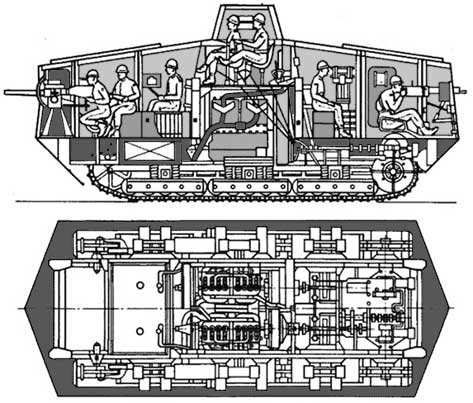 |
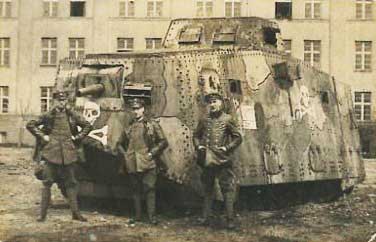 Three officers showing off their A7V tank somewhere in France |
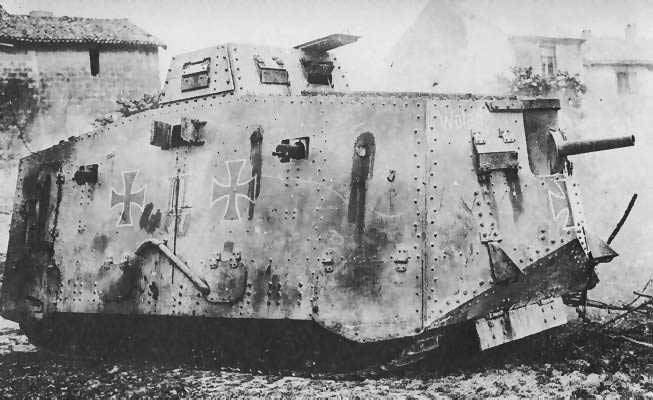 A A7V parked at the pub |
|
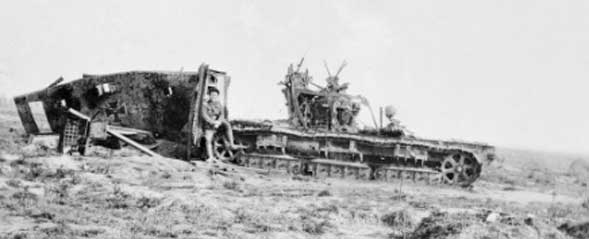 Not a pretty picture :( Deutsches Panzermuseum - German Tank Museum WWI Tanks in the Fiddlersgreen collection (Feb 2011)
|
|
 |
What Someone Else Said...
While looking for cardstock buildings for model rail I came across the Fiddlers Green web site and I noticed that you have a model of the German A7V World War I Tank. I am a volunteer at the Workshops Rail Museum in Ipswich, Qld, Australia which now houses "Mephisto", the only remaining A7V in the world. Mephisto was at the Queensland Museum in Brisbane, but it was removed after the January 2011 floods and given a major clean up and a sort of restoration. Until it has a permanent home in the Queensland Museum, we have it now in our Railway Museum inside a protective plastic de-humidifying bubble. If you like I can send you some photos of the one and only "Mephisto" to include with the information already on your website.
Although I have no official capacity to represent the Museum as I'm only a volunteer, I would like to enquire if there's a way that we could on-sell the plans for your A7V model at the Museum Shop. The sales volumes would not be large as it is mainly dedicated Rail fans who visit the museum, but it would be another service we could offer to our visitors. If this is a possibility I can take it up with the Museum management.
Please let me know about the photographs, and the A7V plans.
Regards, Ken Glasson
Dear Ken,
Thank you for your fine letter and wonderful offer. Although I am the owner of this business, I am also very much a volunteer. I encourage others to volunteer as well, and if you feel you can be of assistance in any way at all with the A7V Panzerkampfwagen, then please join with us. I'm sure that there is plenty you would enjoy helping with. Your suggestions are marvelous. In fact, I might even use your letter on the web page for the A7V tank. - YMP Scott
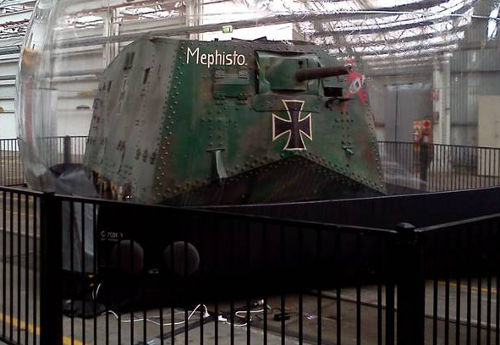



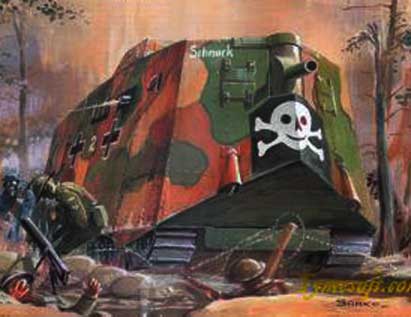 Mark IVs (two Female machine gun-armed tanks and one Male with two 6-pounder guns) near Villers-Bretonneux. During the battle tanks on both sides were damaged. According to the lead tank commander, 2nd Lt Frank Mitchell, the Female Mk IVs fell back after being damaged by armour piercing bullets. They were unable to damage the A7Vs with their own machine guns. Mitchell then attacked the lead German tank, commanded by 2nd Lt Wilhelm Biltz,with the 6 pounders of his own tank and knocked it out. He hit it three times, and killed five of the crew when they bailed out. He then went on to rout some infantry with case shot. The two remaining A7Vs in turn withdrew. As Lt. Mitchell's tank withdrew from action, seven Whippet tanks also engaged the infantry. Four of these were knocked out in the battle, and it is unclear if any of them engaged the retreating German tanks. Lt. Mitchell's tank lost a track towards the end of the battle from a mortar shell and was abandoned. The damaged A7V was later recovered by German forces.
Mark IVs (two Female machine gun-armed tanks and one Male with two 6-pounder guns) near Villers-Bretonneux. During the battle tanks on both sides were damaged. According to the lead tank commander, 2nd Lt Frank Mitchell, the Female Mk IVs fell back after being damaged by armour piercing bullets. They were unable to damage the A7Vs with their own machine guns. Mitchell then attacked the lead German tank, commanded by 2nd Lt Wilhelm Biltz,with the 6 pounders of his own tank and knocked it out. He hit it three times, and killed five of the crew when they bailed out. He then went on to rout some infantry with case shot. The two remaining A7Vs in turn withdrew. As Lt. Mitchell's tank withdrew from action, seven Whippet tanks also engaged the infantry. Four of these were knocked out in the battle, and it is unclear if any of them engaged the retreating German tanks. Lt. Mitchell's tank lost a track towards the end of the battle from a mortar shell and was abandoned. The damaged A7V was later recovered by German forces.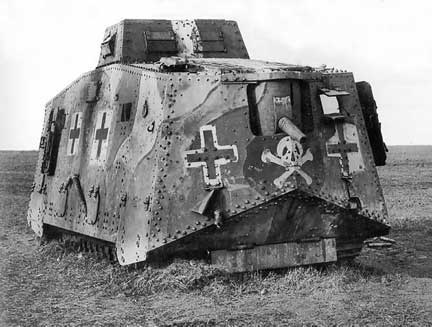 There is no question that World War I was decided by the tank. But it was the first war in history in which technological and economic factors played an important role. The veritable revolution in the art of war began with the appearance on the battlefield of tanks and other motor vehicles. Thus the importance of an industrial technology and economic power on the outcome of a war was clear to see.
There is no question that World War I was decided by the tank. But it was the first war in history in which technological and economic factors played an important role. The veritable revolution in the art of war began with the appearance on the battlefield of tanks and other motor vehicles. Thus the importance of an industrial technology and economic power on the outcome of a war was clear to see.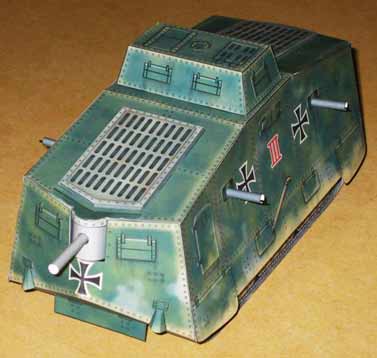
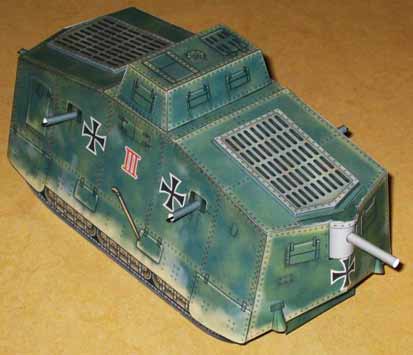
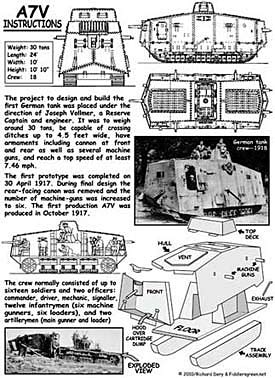

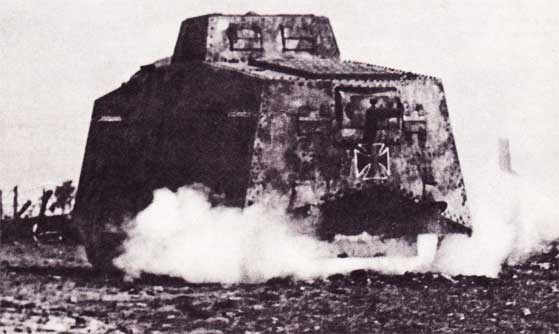 The A7V moved briskly at 10mph and could travel up to 55 miles via road, or 27 miles across terrain with the fuel it carried. The A7V had a ground clearance of only 5 inches, and could cross trenches up to 7 feet.
The A7V moved briskly at 10mph and could travel up to 55 miles via road, or 27 miles across terrain with the fuel it carried. The A7V had a ground clearance of only 5 inches, and could cross trenches up to 7 feet. 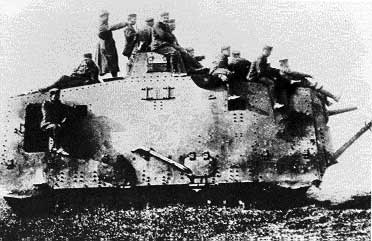 The A7V German WWI Tank was armed with six 7.9mm Machine Gewehr ’08 and could carry up to 15,000 rounds of ammunition for these machine guns. The primary weapon for the A7V, however, was the L/26.3 caliber, 57mm Maxim-Nordfeldt quick firing gun. A skilled crew could fire off up to 25 rounds a minute. The 57mm had a range of about 5 miles. The A7V carried up to one hundred rounds for the quick firing gun with the shells varying from grape-shot to armor-piercing to high-explosive.
The A7V German WWI Tank was armed with six 7.9mm Machine Gewehr ’08 and could carry up to 15,000 rounds of ammunition for these machine guns. The primary weapon for the A7V, however, was the L/26.3 caliber, 57mm Maxim-Nordfeldt quick firing gun. A skilled crew could fire off up to 25 rounds a minute. The 57mm had a range of about 5 miles. The A7V carried up to one hundred rounds for the quick firing gun with the shells varying from grape-shot to armor-piercing to high-explosive.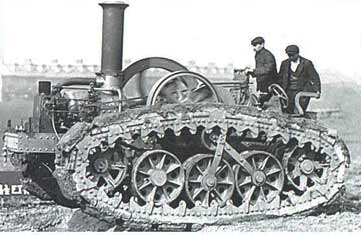 was based on the Holt tractor (left), parts for which were obtained from Austria, where it was produced under licence. The first prototype was completed by Daimler-Benz and tested in April 1917.
was based on the Holt tractor (left), parts for which were obtained from Austria, where it was produced under licence. The first prototype was completed by Daimler-Benz and tested in April 1917. 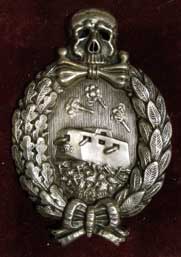 Kraftwagen (roughly "assault armored motor vehicle").
Kraftwagen (roughly "assault armored motor vehicle"). 